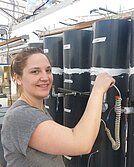Quantifying Soluble Salt Removal in Swelling Soils using Subsurface Drainage

Rebecca Schewe is a M.S. student in the Soil Science program at North Dakota State University. She started her education at Lake Superior State University with a B.S. in Environmental Chemistry. She conducted research as an undergraduate on sequential trace metal analysis to quantify contamination and environmental health of the Munuscong Watershed. Rebecca is continuing her research in soils with a focus on water flow and salt transport in swelling clay soils of the Red River Valley.
Fellow: Rebecca Schewe
Advisor: Dr. Abbey Wick – Assistant Professor, School of Natural Resource Sciences
Co-Advisor: Dr. Francis Casey – Professor and Director, School of Natural Sciences
Degree Progress: M.S. in Soil Science, expected graduation in May 2016.
Quantifying Soluble Salt Removal in Swelling Soils using Subsurface Drainage
Subsurface tile drainage has gained tremendous popularity in eastern North Dakota for its effectiveness in removing detrimental soluble salts. With the installation of tile drainage, salts can be prevented from entering the soil root zone from the groundwater. The tile drainage intercepts the rising water table, conducting the soil water and its constituents to surface drainage networks that eventually flow to rivers and streams. Quantifying the amount of salt leached with surface-applied water can provide important information on the effectiveness of tile drainage in reducing soil salinity. Additionally, this data can provide important information on the effects of tile drainage on surface water quality in North Dakota.
Project Objectives:
Using laboratory column experiments to accelerate field hydrologic processes to determine how much water is necessary to leach salts from soils and enhance soil productivity.
- Experimentally quantify the removal of soluble salts from tile drainage using large soil columns and multiple wetting and drying cycles.
- Simulate the water transfer and salt removal from tile drainage using the numerical program HYDRUS-1D. Modelling will help identify the processes of water movement and salt mobility in these swelling soils, and aid in developing predictive calculations.
- Using experimental and model results to develop a tool that would help producers gauge the effectiveness of tile drainage in removing soluble salts, and the time to recuperate a return in their investment.
Progress:
Progress of the project includes preliminary research of a literature review and an ideal experimental procedure for the accelerated field processes. The soil monoliths have been harvested, instrumented, and the first application of water through all cores is complete. Currently, the cores are in the drying process while chemical analysis including EC, pH, cations (Na+, K+, Mg2+, Ca2+) and anions (Cl-, SO42-) is finalized from the collected leachate. A numerical model using HYDRUS 1-D has been compared to experimental results of tensiometer readings during the infiltration of water through the cores. Two presentation abstracts are in progress for presentation at the ASA, CSSSA, and SSSA conference in Minneapolis, MN November 15-18.
Significance:
Managing agricultural land and water for food production is critically import due to a growing global human population and its demands for food and fresh water. Food production challenges grow annually, because greater productivity is needed from the limited available land currently in production. A major obstacle for optimal crop production in North Dakota originates from a natural wet cycle (Euliss and Mushet, 2011) that has mobilized soluble salts, bringing them to the soil surface, and decreasing land productivity.
Soluble salts precipitate at the land surface and deposit throughout the root zone as a result of higher water tables and the evapotranspiration processes. Higher salt concentrations in the root zone cause plants to dehydrate by lowering the osmotic potential that allows plants to uptake water, which reduces crop yield (Katerji et al., 1997). Heavy precipitation events and spring ground water recharge are the only sources of natural fresh water that have the potential to solubilize and leach salts deeper in the subsurface.
Implementation of tile drainage can reduce the salinity in the upper portion of the soil profile by leaching the salts down and removing them with subsequent tile drainage. However, not all producers in the Red River Valley who have installed tile drainage have observed remediated soil salinity. This research focuses on quantifying the removal of salt from leaching water in Red River Valley soils to provide producers with better understanding of tile drainage as a tool to reduce soil salinity.

Abbey Wick
Department of Soil Science
Telephone: 701-850-6458
Email: abbey.wick@ndus.edu

Francis Casey
School of Natural Resource Sciences
Office: Walster 123
Phone: 701-231-8577


